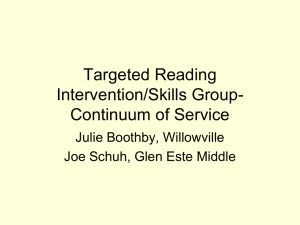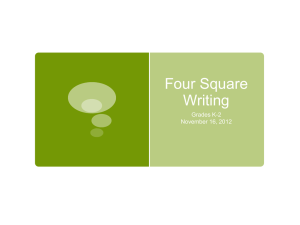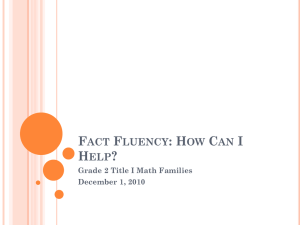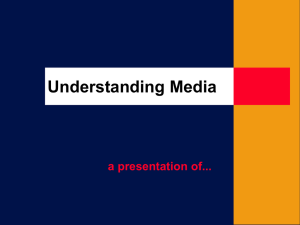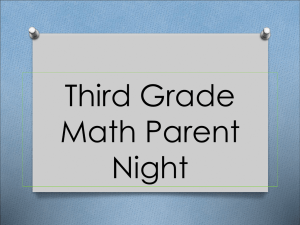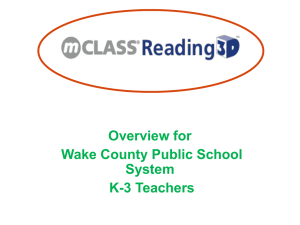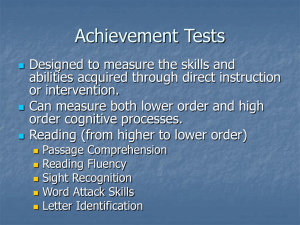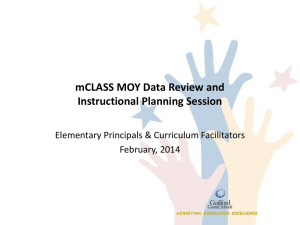MOY Reminders
advertisement
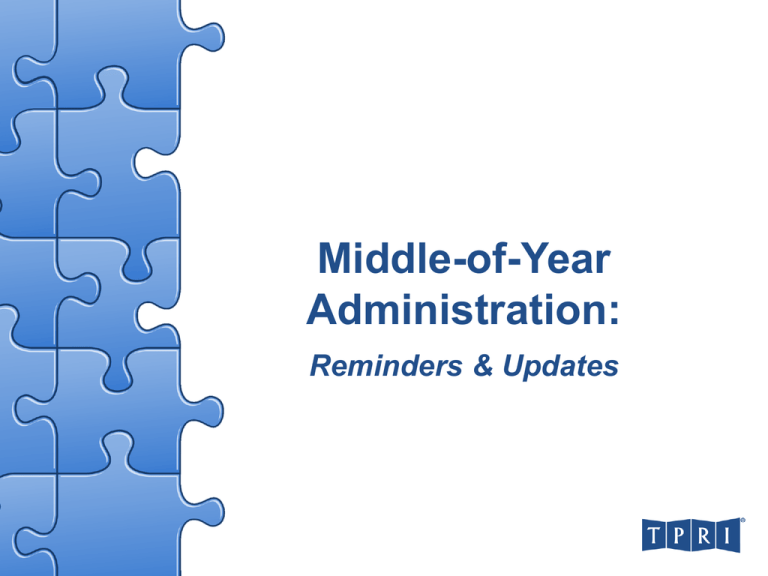
Middle-of-Year Administration: Reminders & Updates Contents Slide 3 ……………. When to Administer MOY Slide 4 - 5………… New Students Slide 6 ……………. TPRI Administration Videos Slides 7 – 10 …….. Kindergarten Slides 11 – 24 …… Grade 1 Slides 25 – 37 …… Grade 2 Slides 38 – 51 …… Grade 3 Slides 52 – 53 …… PMER Slide 54 ………….. PMBR Slide 55 …………... Contact Information 2 When to Administer MOY • For Kindergarten through Grade 3, TPRI recommends MOY administration begin mid-January. • Individual schools and school districts set the specific dates for their TPRI administration windows to open and close. • TPRI recommends an administration window of 2 weeks or less. 3 New Students 4 • The TPRI should be administered to new students soon after they enter your class. • For students entering your class within one to two weeks after completing BOY, MOY or EOY administration, assess the student using the same procedures used with all students at these time points. New Students (cont.) 5 • For students entering your class more than two weeks after administration is complete, the TPRI can be a helpful tool. It can provide the teacher with important information about the instructional needs of the new student. Use of this data beyond the classroom would be determined by your campus or district. Follow these guidelines during the different time points: – After BOY and after EOY, do not administer the tasks on the Screening Section because screening results are reliable only during the specified administration window. Instead, begin with the first task of the Inventory Section (PA-1 at kindergarten and first grade, GK-1 at second and third grades) and then follow the Branching Rules. – After MOY, assess the student using the same procedure used with all students. TPRI Administration Videos • Training videos have been created for each grade level so that teachers can view proper administration of each TPRI Screening and Inventory task. • Please click on the following link to access the TPRI Administration Videos: http://tpri.org/resources/videos/index.html 6 Kindergarten MOY Reminders • At MOY there is no Screening Section. • All students take the Listening Comprehension portion of the Inventory Section (like they did at BOY). Kindergarten 7 Jumping-In at MOY in Kindergarten • If you DID administer the PA and GK portions of the inventory at BOY: – At MOY, do not administer those PA/GK tasks where the student scored Developed (D). – If the student was Still Developing (SD) on a task at BOY, re-administer every item on the task and then follow the Branching Rules. Kindergarten 8 Jumping-In at MOY in Kindergarten (cont.) • If you DID NOT administer the PA and GK portions of the inventory at BOY: – At MOY, you may choose to administer the PA and GK portions of the inventory if you are concerned about a student’s development and/or current performance level. – If you do administer the PA and GK portions, begin with PA-1 and then follow the Branching Rules. Kindergarten 9 MOY – Kindergarten Listening Comprehension • The Listening Comprehension task at MOY is: COM-MOY. • The MOY story is titled The Tree House. • This task is administered to all students. • Immediately after reading the story aloud to the student, ask the comprehension questions listed on the student record sheet. • Score 1 for correct and 0 for incorrect; do not give ½ points. • Sample answers are provided for guidance, but rely on your professional judgment in scoring responses as correct or incorrect. • Do not repeat the question, and do not provide clues or feedback to aid in answering the questions. Kindergarten 10 Grade 1 MOY Reminders • At MOY there is no Screening Section. • All students take the Word Reading and the Reading Accuracy, Fluency and Comprehension portions of the Inventory Section (like they did at BOY). Grade 1 11 Jumping-In at MOY in Grade 1 12 • If you DID administer the PA and GK portions of the inventory at BOY: – At MOY, do not administer those PA/GK tasks where the student scored Developed (D). – If the student was Still Developing (SD) on a task at BOY, re-administer every item on the task and then follow the Branching Rules. Grade 1 Jumping-In at MOY in Grade 1 (cont.) 13 • If you DID NOT administer the PA and GK portions of the inventory at BOY: – At MOY, you may choose to administer the PA and GK portions of the inventory if you are concerned about a student’s development and/or current performance level. – If you do administer the PA and GK portions, begin with PA-1 and then follow the Branching Rules. Grade 1 Word Reading at MOY • The same word list is used at BOY, MOY & EOY. • Students who scored D on all 4 Word Reading sets at BOY do not have to take the Word Reading task. All other students are administered the Word Reading task. • If the student scored D on a set at BOY, that set does not have to be administered at MOY. – Teachers may find it easier to have students read all the sets on the word list, regardless of BOY performance. This is acceptable. • If a student cannot read any of the words in Set 1 correctly, stop the task. • If a student scores correct on 4 or 5 words in a set, then score D for the set. Grade 1 14 Scoring the Word Reading Task 15 • Score words as correct (1) or incorrect (0). • For instructional planning, record incorrect responses as the student reads. – Use phonetic spelling that will later allow you to recall the answer the student provided. • Complete the Error Analysis Chart for students for whom you will provide targeted GK instruction. – Do not complete the Error Analysis Chart while you are with the student. Grade 1 MOY – Grade 1 Reading Accuracy, Fluency & Comprehension 16 • The Reading Accuracy, Fluency & Comprehension task at MOY is: READ-MOY. • This portion is administered to all students. • The MOY stories are: – Story 3 – Rex – Story 4 – Bats • All students attempt to read both stories. If the student reaches the Frustrational Level (FRU) on either story, then read the story to the student. Grade 1 Grade 1 Story Difficulty Levels • The difficulty level of the two MOY stories is similar to the two BOY stories. BOY Story 1 (fiction) Story 2 (fiction) Easier Harder MOY Story 3 (fiction) Story 4 (fiction) Easier Harder Grade 1 17 Correct Story Reading Administration & Scoring 18 • SAY: I’m going to ask you to read a story. The title of the story is _____________. After you read it, I’ll ask you a few questions. Read the story out loud to me. • DO: Place the Story Booklet in front of the student. Start the stopwatch when the student reads the first word of the story. As the student reads, mark errors on the Student Record Sheet. • Mark any words not read correctly with a slash ( / ) on the Student Record Sheet. Grade 1 Correct Story Reading Administration & Scoring 19 • Story reading errors include: – – – – – Mispronunciations – The student pronounces the word incorrectly. This includes leaving off –s, –ed and –ing endings. Substitutions – The student replaces the correct word with a different word. Omissions – The student skips a word. Reversals – The student reads adjacent words in the wrong order. Hesitations – The student pauses for longer than 3 seconds or takes longer than 3 seconds to sound out a word. In these cases, provide the word and count it as an error. • Items not considered errors: – – – – Insertions – The student adds a whole word that does not appear in the text. Self-corrections – The student makes an error, but then corrects the error. Repetitions – The student reads the same word or phrase multiple times. Loss of place – The student skips a line or loses their place. Redirect the student to the correct place in the story and allow the stopwatch to continue to run. • If the student reads the same word incorrectly multiple times throughout a story, count the word as an error each time it is read incorrectly. All words, including names, are scored in the same way. Grade 1 When Should the Teacher Provide the Word to the Student? • If the student makes a mistake and keeps reading, the teacher marks the error but stays silent. Do not provide the word or intervene in any way. • If the student comes to a word and pauses for three seconds, or attempts to sound out a word for three seconds without producing it, this is considered a "three second hesitation." With three second hesitations, provide the word, then mark the word as an error on the score sheet. Grade 1 20 MOY – Grade 1 Reading Comprehension 21 • Immediately following the reading, ask the comprehension questions listed on the student record sheet. • Score 1 for correct and 0 for incorrect; do not give ½ points. • Sample answers are provided for guidance, but rely on your professional judgment in scoring responses as correct or incorrect. • Do not repeat the question, and do not provide clues or feedback to aid in answering the questions. Grade 1 Scoring Developed (D) for Reading Comprehension 22 • Students who listen to a story after reaching frustration cannot score D for Reading Comprehension. • On an individual story students can score D for reading comprehension by answering 5-6 questions correctly, but there is not an overall D criteria for reading comprehension. • To consider students' comprehension scores in relation to each other (when grouping students, for example), there are two common and efficient approaches: – Look at whether students scored D on both stories, 1 story or 0 stories. – Look at the total number of comprehension questions that students answered correctly for both stories. Grade 1 Determining Average Fluency Rates 23 • Average fluency rates for the two stories (Story 3 & Story 4) can be used for reporting, grouping students and/or for planning instruction. • If a student scores at the Frustrational Level on a story, do not calculate the fluency rate. • Students who reach frustration on both Story 3 & 4 will not have an average fluency rate. • If the student is only able to read one story, then the teacher records the fluency rate for that one story as the average. • If the student is able to read both stories at the Instructional or Independent Level, then the average fluency rate is determined using this formula: (Story 3 rate + Story 4 rate) ÷ 2 = Avg. rate Grade 1 Fluency Equating 24 • What is Fluency Equating? – TPRI provides tools to help teachers measure and understand fluency scores more effectively. These tools come in the form of Fluency Equating Tables. With equated fluency scores teachers can reflect on student fluency without concern for how many TPRI stories were read, which story was read, or how difficult the stories were. • Why use Fluency Equating Tables? – When students receive multiple fluency scores, and read stories of varying difficulty, it is sometimes hard to tell if students are improving from one time point to the next. • To find out more about TPRI Fluency Equating Tables, click to read about them in our February, 2012 newsletter. Grade 1 Grade 2 MOY Reminders • At MOY there is no Screening Section. • All students take the Word Reading and the Reading Accuracy, Fluency and Comprehension portions of the Inventory Section (like they did at BOY). Grade 2 25 Grade 2 MOY Spelling Task 26 • The same word list is used at BOY, MOY & EOY. • The spelling task is administered to the whole class at once, in small groups or individually. • If the student scored D on a set at BOY, that set does not have to be administered at MOY. Since the spelling portion of the assessment is typically administered to the whole group, in most cases all sets will be administered to all students regardless of their performance at BOY. • Score words as correct (1) or incorrect (0). • Complete the Error Analysis Chart for students for whom you will provide targeted GK instruction. Grade 2 Word Reading at MOY • The same word list is used at BOY, MOY & EOY. • Students who scored D on all 4 Word Reading sets at BOY do not have to take the Word Reading task. All other students are administered the Word Reading task. • If the student scored D on a set at BOY, that set does not have to be administered at MOY. – Teachers may find it easier to have students read all the sets on the word list, regardless of BOY performance. This is acceptable. • If a student cannot read any of the words in Set 1 correctly, stop the task. • If a student scores correct on 4 or 5 words in a set, then score D for the set. Grade 2 27 Scoring the Word Reading Task 28 • Score words as correct (1) or incorrect (0). • For instructional planning, record incorrect responses. – Use phonetic spelling that will later allow you to recall the answer the student provided. • Complete the Error Analysis Chart for students for whom you will provide targeted GK instruction. – Do not complete the Error Analysis Chart while you are with the student. Grade 2 MOY – Grade 2 Reading Accuracy, Fluency & Comprehension 29 • The Reading Accuracy, Fluency & Comprehension task at MOY is: READ-MOY. • This portion is administered to all students. • The MOY stories are: – Story 3 – Spring Break – Story 4 – Meat-Eating Plants • All students attempt to read both stories. If the student reaches the Frustrational Level (FRU) on either story, then read the story to the student. Grade 2 Grade 2 Story Difficulty Levels • The difficulty level of the two MOY stories is similar to the two BOY stories. BOY Story 1 (fiction) Story 2 (non-fiction) Easier Harder MOY Story 3 (fiction) Story 4 (non-fiction) Easier Harder Grade 2 30 Correct Story Reading Administration & Scoring 31 • SAY: I’m going to ask you to read a story. The title of the story is _____________. After you read it, I’ll ask you a few questions. Read the story out loud to me. • DO: Place the Story Booklet in front of the student. Start the stopwatch when the student reads the first word of the story. As the student reads, mark errors on the Student Record Sheet. • Mark any words not read correctly with a slash ( / ) on the Student Record Sheet. Grade 2 Correct Story Reading Administration & Scoring • Story reading errors include: – – – – – • Mispronunciations – The student pronounces the word incorrectly. This includes leaving off –s, –ed and –ing endings. Substitutions – The student replaces the correct word with a different word. Omissions – The student skips a word. Reversals – The student reads adjacent words in the wrong order. Hesitations – The student pauses for longer than 3 seconds or takes longer than 3 seconds to sound out a word. In these cases, provide the word and count it as an error. Items not considered errors: – – – – • 32 Insertions – The student adds a whole word that does not appear in the text. Self-corrections – The student makes an error, but then corrects the error. Repetitions – The student reads the same word or phrase multiple times. Loss of place – The student skips a line or loses their place. Redirect the student to the correct place in the story and allow the stopwatch to continue to run. If the student reads the same word incorrectly multiple times throughout a story, count the word as an error each time it is read incorrectly. All words, including names, are scored in the same way. Grade 2 When Should the Teacher Provide the Word to the Student? • If the student makes a mistake and keeps reading, the teacher marks the error but stays silent. Do not provide the word or intervene in any way. • If the student comes to a word and pauses for three seconds, or attempts to sound out a word for three seconds without producing it, this is considered a "three second hesitation." With three second hesitations, provide the word, then mark the word as an error on the score sheet. Grade 2 33 MOY – Grade 2 Reading Comprehension 34 • Immediately following the reading, ask the comprehension questions listed on the student record sheet. • Score 1 for correct and 0 for incorrect; do not give ½ points. • Sample answers are provided for guidance, but rely on your professional judgment in scoring responses as correct or incorrect. • Do not repeat the question, and do not provide clues or feedback to aid in answering the questions. Grade 2 Scoring Developed (D) for Reading Comprehension 35 • Students who listen to a story after reaching frustration cannot score D for Reading Comprehension. • On an individual story students can score D for reading comprehension by answering 5-6 questions correctly, but there is not an overall D criteria for reading comprehension. • To consider students' comprehension scores in relation to each other (when grouping students, for example), there are two common and efficient approaches: – Look at whether students scored D on both stories, 1 story or 0 stories. – Look at the total number of comprehension questions that students answered correctly for both stories. Grade 2 Determining Average Fluency Rates 36 • Average fluency rates for the two stories (Story 3 & Story 4) can be used for reporting, grouping students and/or for planning instruction. • If a student scores at the Frustrational Level on a story, do not calculate the fluency rate. • Students who reach frustration on both Story 3 & 4 will not have an average fluency rate. • If the student is only able to read one story, then the teacher records the fluency rate for that one story as the average. • If the student is able to read both stories at the Instructional or Independent Level, then the average fluency rate is determined using this formula: (Story 3 rate + Story 4 rate) ÷ 2 = Avg. rate Grade 2 Fluency Equating 37 • What is Fluency Equating? – TPRI provides tools to help teachers measure and understand fluency scores more effectively. These tools come in the form of Fluency Equating Tables. With equated fluency scores teachers can reflect on student fluency without concern for how many TPRI stories were read, which story was read, or how difficult the stories were. • Why use Fluency Equating Tables? – When students receive multiple fluency scores, and read stories of varying difficulty, it is sometimes hard to tell if students are improving from one time point to the next. • To find out more about TPRI Fluency Equating Tables, click to read about them in our February, 2012 newsletter. Grade 2 Grade 3 MOY Reminders • At MOY there is no Screening Section. • All students take the Word Reading and the Reading Accuracy, Fluency and Comprehension portions of the Inventory Section (like they did at BOY). Grade 3 38 Assessing New Students 39 • Students who entered your class after the completion of BOY should be assessed at MOY. • With these students, begin MOY assessment with the Spelling or Word Reading tasks, and then follow the Branching Rules. Grade 3 Grade 3 MOY Spelling Task 40 • The same word list is used at BOY, MOY & EOY. • The spelling task is administered to the whole class at once, in small groups or individually. • If the student scored D on a set at BOY, that set does not have to be administered at MOY. Since the spelling portion of the assessment is typically administered to the whole group, in most cases all sets will be administered to all students regardless of their performance at BOY. • Score words as correct (1) or incorrect (0). • Complete the Error Analysis Chart for students for whom you will provide targeted GK instruction. Grade 3 Word Reading at MOY 41 • The same word list is used at BOY, MOY & EOY. • Students who scored D on all 4 Word Reading sets at BOY do not have to take the Word Reading task. All other students are administered the Word Reading task. • If the student scored D on a set at BOY, that set does not have to be administered at MOY. – Teachers may find it easier to have students read all the sets on the word list, regardless of BOY performance. This is acceptable. • If a student can’t read any of the words in Set 1 correctly, stop the task. • If a student scores correct on 4 or 5 words in a set, then score D for the set. Grade 3 Scoring the Word Reading Task 42 • Score words as correct (1) or incorrect (0). • For instructional planning, record incorrect responses. – Use phonetic spelling that will later allow you to recall the answer the student provided. • Complete the Error Analysis Chart for students for whom you will provide targeted GK instruction. – Do not complete the Error Analysis Chart while you are with the student. Grade 3 MOY – Grade 3 Reading Accuracy, Fluency & Comprehension 43 • The Reading Accuracy, Fluency & Comprehension task at MOY is: READ-MOY. • This portion is administered to all students. • The MOY stories are: – Story 3 – Moonbeam – Story 4 – Not a Normal Fish • All students attempt to read both stories. If the student reaches the Frustrational Level (FRU) on either story, then read the story to the student. Grade 3 Grade 3 Story Difficulty Levels • The difficulty level of the two MOY stories is similar to the two BOY stories. BOY Story 1 (fiction) Story 2 (non-fiction) Easier Harder MOY Story 3 (fiction) Story 4 (non-fiction) Easier Harder Grade 3 44 Correct Story Reading Administration & Scoring 45 • SAY: I’m going to ask you to read a story. The title of the story is _____________. After you read it, I’ll ask you a few questions. Read the story out loud to me. • DO: Place the Story Booklet in front of the student. Start the stopwatch when the student reads the first word of the story. As the student reads, mark errors on the Student Record Sheet. • Mark any words not read correctly with a slash ( / ) on the Student Record Sheet. Grade 3 Correct Story Reading Administration & Scoring • Story reading errors include: – – – – – • Mispronunciations – The student pronounces the word incorrectly. This includes leaving off –s, –ed and –ing endings. Substitutions – The student replaces the correct word with a different word. Omissions – The student skips a word. Reversals – The student reads adjacent words in the wrong order. Hesitations – The student pauses for longer than 3 seconds or takes longer than 3 seconds to sound out a word. In these cases, provide the word and count it as an error. Items not considered errors: – – – – • 46 Insertions – The student adds a whole word that does not appear in the text. Self-corrections – The student makes an error, but then corrects the error. Repetitions – The student reads the same word or phrase multiple times. Loss of place – The student skips a line or loses their place. Redirect the student to the correct place in the story and allow the stopwatch to continue to run. If the student reads the same word incorrectly multiple times throughout a story, count the word as an error each time it is read incorrectly. All words, including names, are scored in the same way. Grade 3 When Should the Teacher Provide the Word to the Student? • If the student makes a mistake and keeps reading, the teacher marks the error but stays silent. Do not provide the word or intervene in any way. • If the student comes to a word and pauses for three seconds, or attempts to sound out a word for three seconds without producing it, this is considered a "three second hesitation." With three second hesitations, provide the word, then mark the word as an error on the score sheet. Grade 3 47 MOY – Grade 3 Reading Comprehension 48 • Immediately following the reading, ask the comprehension questions listed on the student record sheet. • Score 1 for correct and 0 for incorrect; do not give ½ points. • Sample answers are provided for guidance, but rely on your professional judgment in scoring responses as correct or incorrect. • Do not repeat the question, and do not provide clues or feedback to aid in answering the questions. Grade 3 Scoring Developed (D) for Reading Comprehension 49 • Students who listen to a story after reaching frustration cannot score D for Reading Comprehension. • On an individual story students can score D for reading comprehension by answering 5-6 questions correctly, but there is not an overall D criteria for reading comprehension. • To consider students' comprehension scores in relation to each other (when grouping students, for example), there are two common and efficient approaches: – Look at whether students scored D on both stories, 1 story or 0 stories. – Look at the total number of comprehension questions that students answered correctly for both stories. Grade 3 Determining Average Fluency Rates 50 • Average fluency rates for the two stories (Story 3 & Story 4) can be used for reporting, grouping students and/or for planning instruction. • If a student scores at the Frustrational Level on a story, do not calculate the fluency rate. • Students who reach frustration on both Story 3 & 4 will not have an average fluency rate. • If the student is only able to read one story, then the teacher records the fluency rate for that one story as the average. • If the student is able to read both stories at the Instructional or Independent Level, then the average fluency rate is determined using this formula: (Story 3 rate + Story 4 rate) ÷ 2 = Avg. rate Grade 3 Fluency Equating 51 • What is Fluency Equating? – TPRI provides tools to help teachers measure and understand fluency scores more effectively. These tools come in the form of Fluency Equating Tables. With equated fluency scores teachers can reflect on student fluency without concern for how many TPRI stories were read, which story was read, or how difficult the stories were. • Why use Fluency Equating Tables? – When students receive multiple fluency scores, and read stories of varying difficulty, it is sometimes hard to tell if students are improving from one time point to the next. • To find out more about TPRI Fluency Equating Tables, click to read about them in our February, 2012 newsletter. Grade 3 Using the PMER After MOY Kindergarten • After the MOY Benchmark Assessment reevaluate student performance and determine whether to continue use of the PMER. • If the student was assessed with the PMER during the first semester, start with the set where the student left off prior to the MOY benchmark assessment. • If the student was not assessed with the PMER during the first semester, start with Set 14 and continue every two weeks in sequence. PMER 52 Using the PMER After MOY – Grade 1 • After the MOY Benchmark Assessment reevaluate student performance and determine whether to continue monitoring progress. • Attempt to use the PMBR kit. If the student is frustrated on the easiest story, use the PMER. – If the student was assessed with the PMER during the first semester, start with the set where the student left off prior to the MOY benchmark assessment. – If the student was not assessed with the PMER during the first semester, start with Grade 1, Set 2 and continue every two weeks in sequence. PMER 53 Using the PMBR after MOY 54 • 2-Week Schedule – Start with Story 1 for the student’s grade level. Move back to Story 1 for the previous grade if the student is frustrated. – For students who are frustrated on Grade 1, Story 1, move back to the PMER kit. • 6-Week Schedule – Use the timed word list to place the student into a story. – If the student is frustrated, back up to the previous story. – If the student is frustrated on Story 1 for her/his grade level, use their word list score to place into a story for the previous grade level. – For students who are frustrated on Grade 1, Story 1, move back to the PMER kit. PMBR Questions? If you have any questions, please contact us at: tpri@uth.tmc.edu OR Check the Frequently Asked Questions section of the website: http://www.tpri.org/faqs/index.html 55


